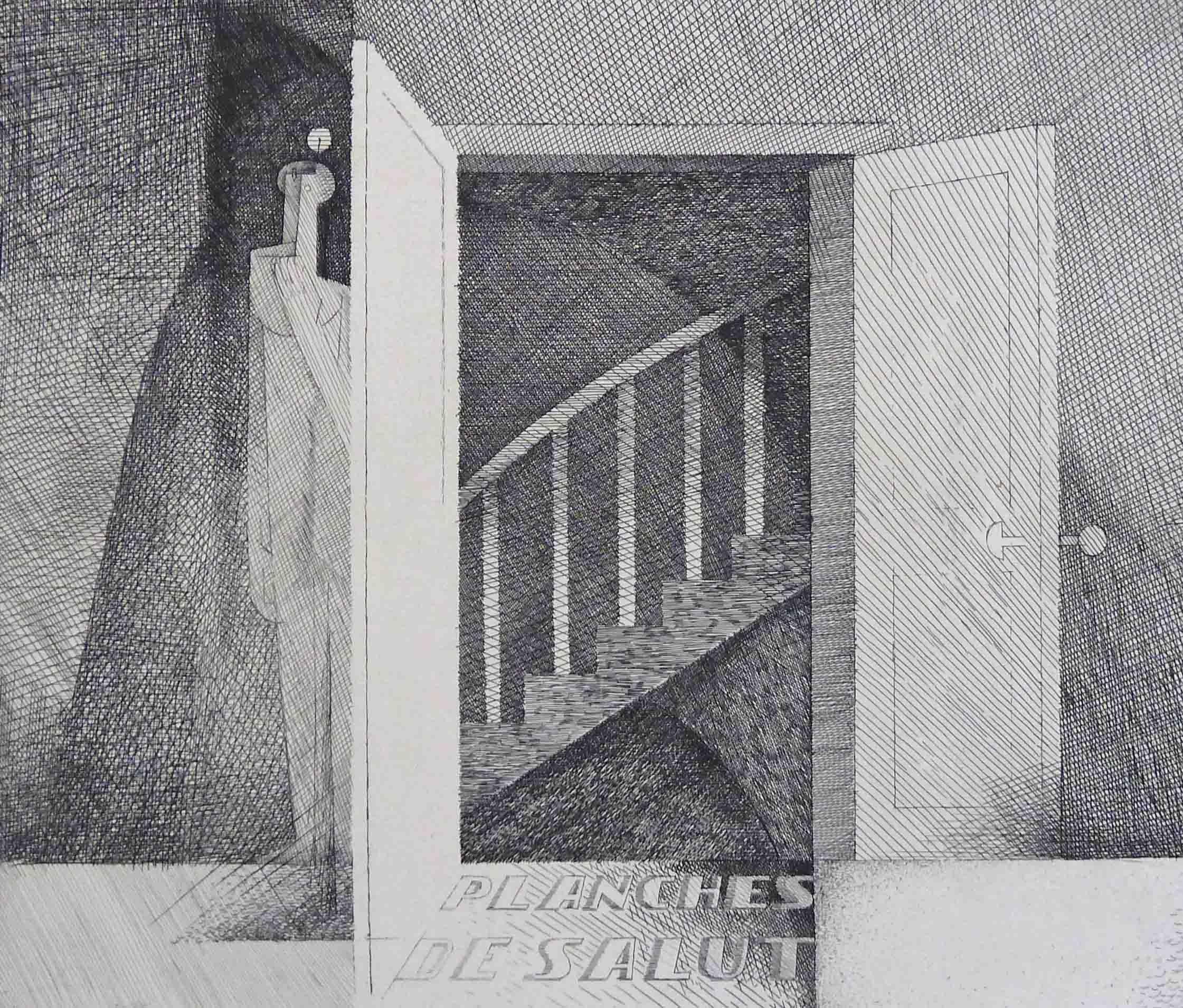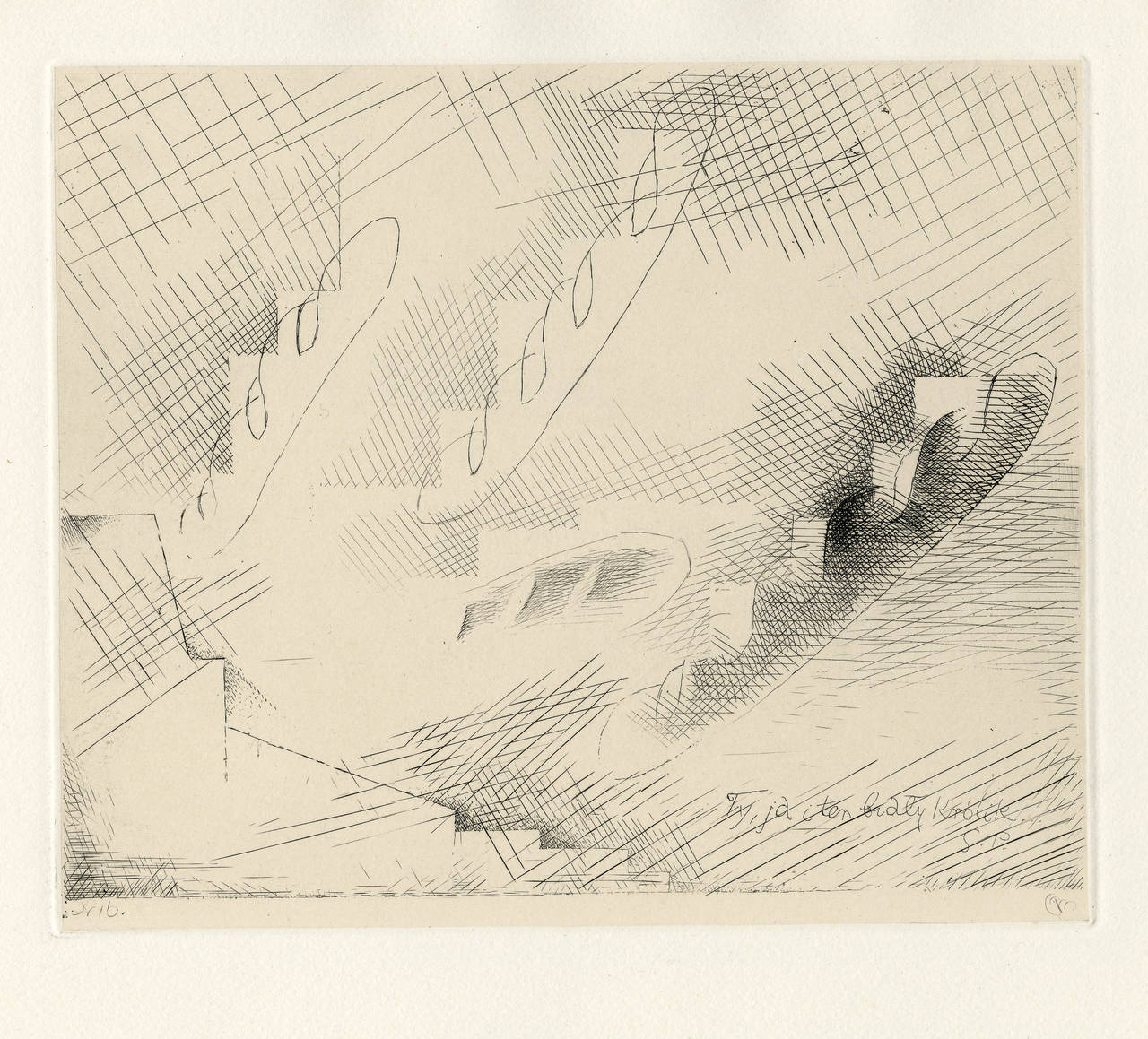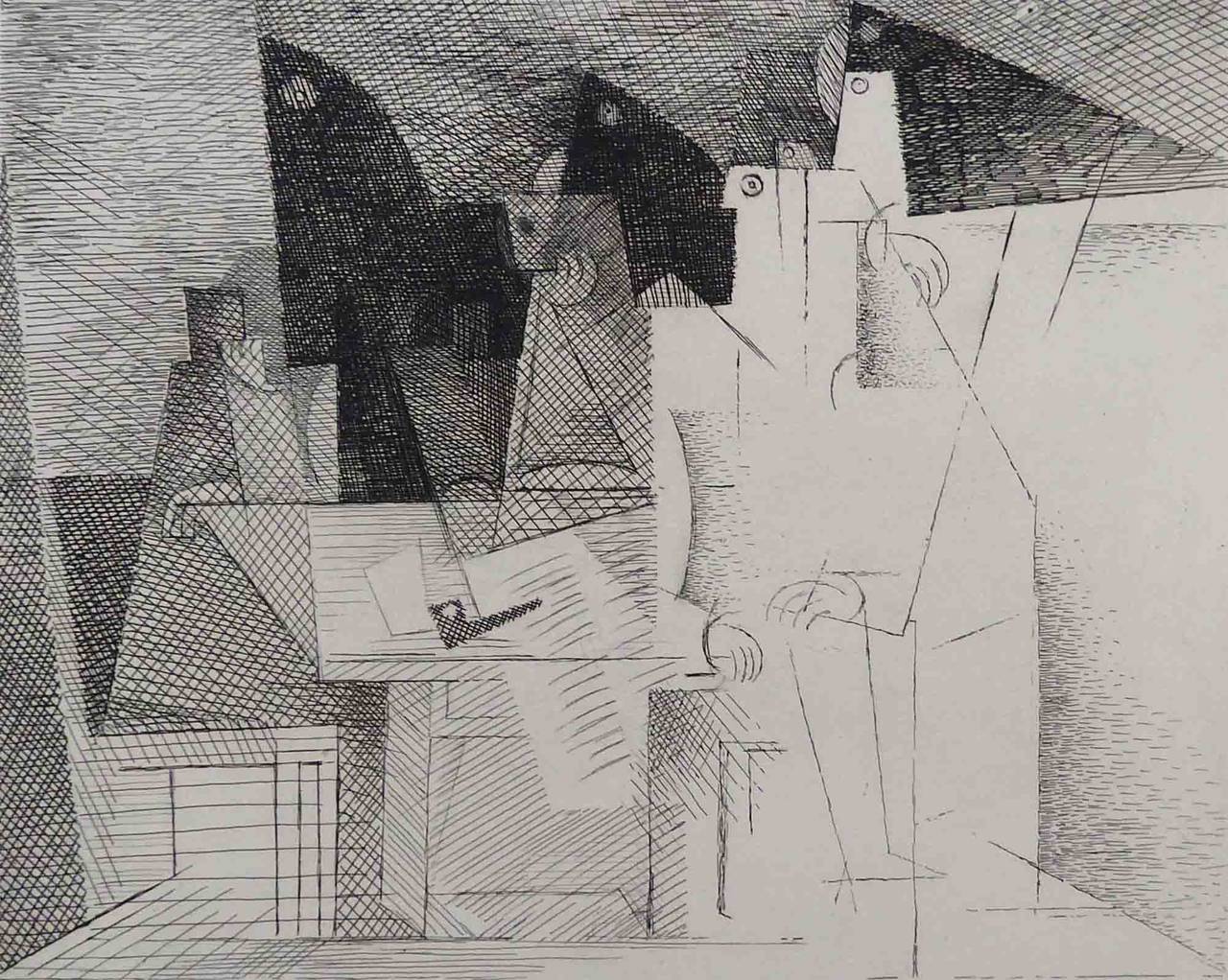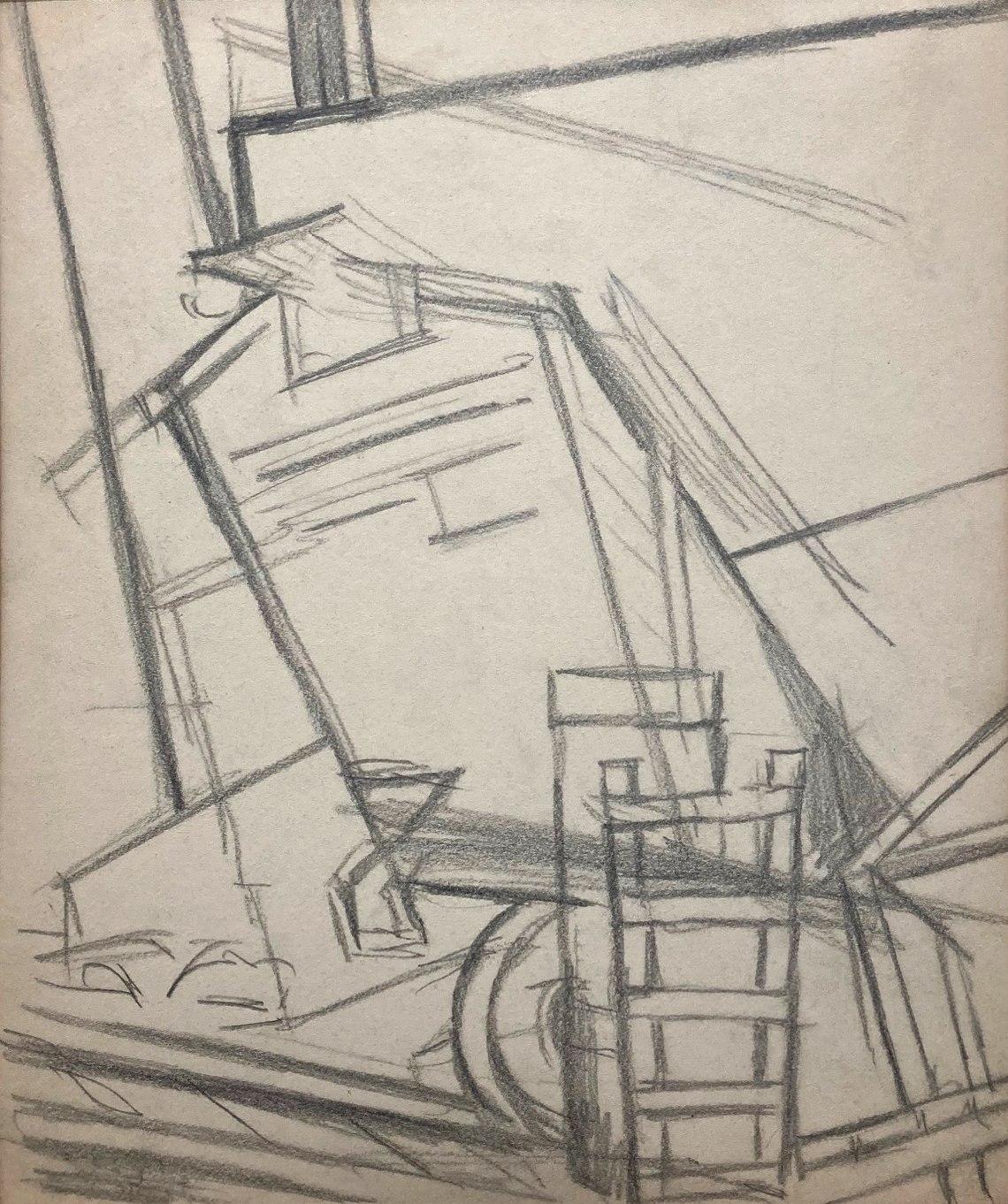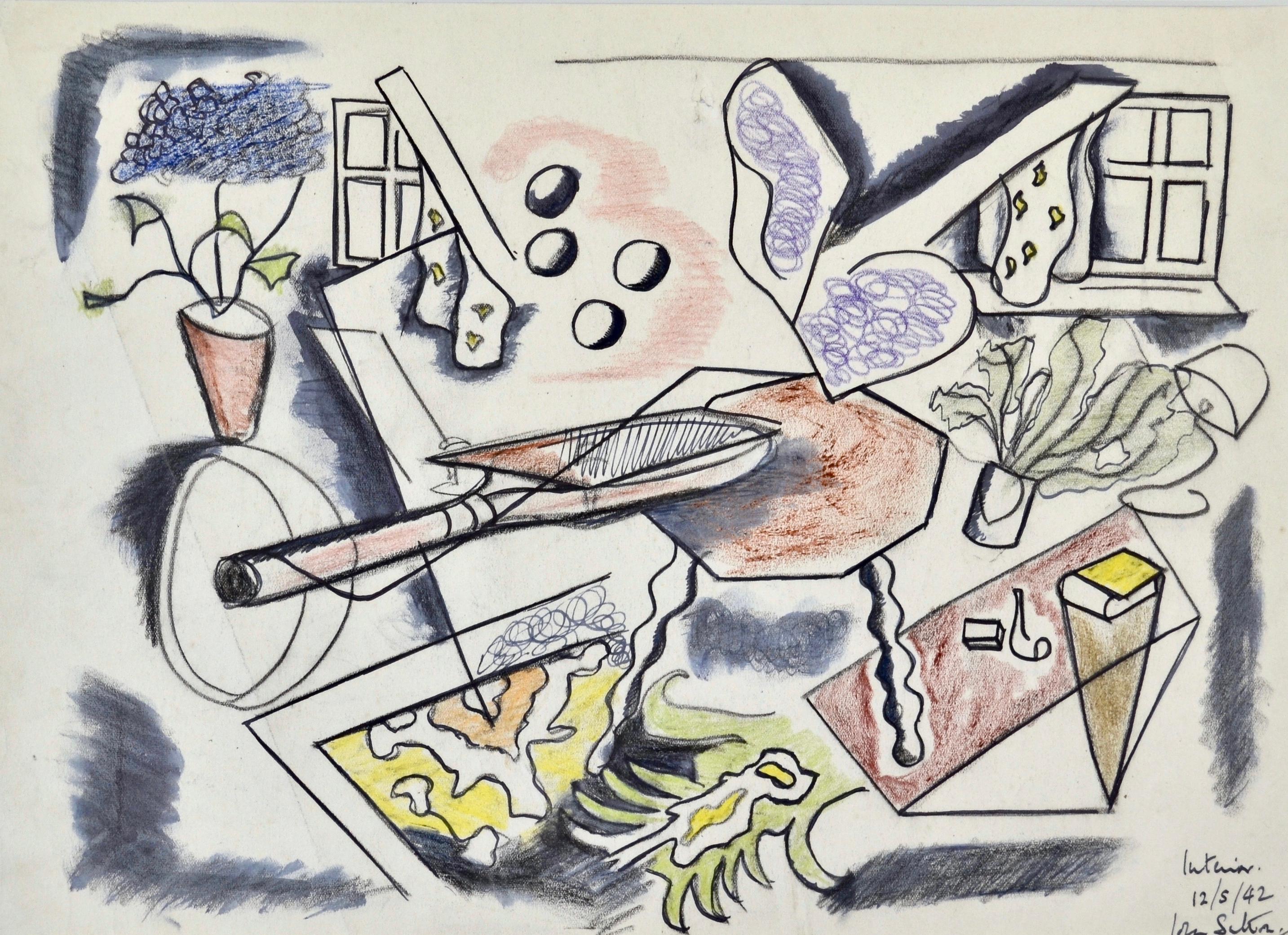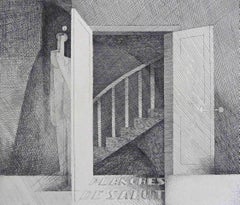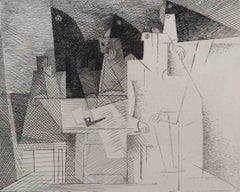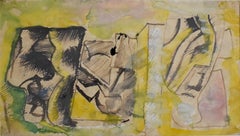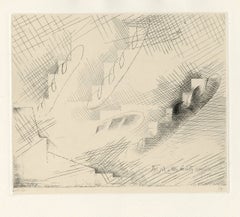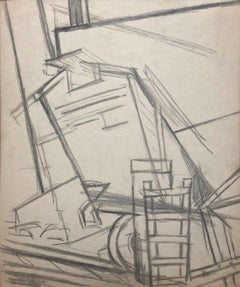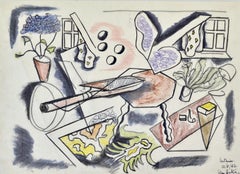Items Similar to The Balcony (Drawing for Plate I, Planches de Salut)
Want more images or videos?
Request additional images or videos from the seller
1 of 7
Louis MarcoussisThe Balcony (Drawing for Plate I, Planches de Salut)1930
1930
$18,000
£13,956.67
€15,836.45
CA$25,802.23
A$28,056.25
CHF 14,782.90
MX$340,801.99
NOK 185,850.94
SEK 174,220.24
DKK 118,838.77
About the Item
LOUIS MARCOUSSIS (1883-1941)
(Ludwik Kazimierz Wladyslaw Markus)
1878 or 1883 Łódź, Poland – 1941, Cusset, France
(Polish/French)
Title: The Balcony (Drawing for Plate I, Planches de Salut), 1930
Technique: Original Hand Signed and Dated Drawing in Pencil on paper laid on vellum paper
Paper size: 30.8 x 40.3 cm / 12.1 x 15.8 in
Image size: 18 x 23.2 cm / 7.1 x 9.2 in
Additional Information: This drawing is Hand Signed “Marcoussis” in the lower left corner.
It is Hand dated next to the signature “1930”.
It is a preparatory drawing for plate I of Planches de Salut, a book of 13 etchings published by Jeanne Bucher and printed by Lacourière, Paris, 1931.
It is inspired by Charles Baudelaire's poem "The Balcony", from his famous collections of poems, Fleurs du Mal.
Line 16 from this poem "The night was growing dense like an encircling wall", appears in the pge preceeding the etching in the portfolio.
The Balcony, by Charles Baudelaire
Mother of memories, mistress of mistresses,
O you, all my pleasure, O you, all my duty!
You'll remember the sweetness of our caresses,
The peace of the fireside, the charm of the evenings.
Mother of memories, mistress of mistresses!
The evenings lighted by the glow of the coals,
The evenings on the balcony, veiled with rose mist;
How soft your breast was to me! how kind was your heart!
We often said imperishable things,
The evenings lighted by the glow of the coals.
How splendid the sunsets are on warm evenings!
How deep space is! how potent is the heart!
In bending over you, queen of adored women,
I thought I breathed the perfume in your blood.
How splendid the sunsets are on warm evenings!
The night was growing dense like an encircling wall,
My eyes in the darkness felt the fire of your gaze
And I drank in your breath, O sweetness, O poison!
And your feet nestled soft in my brotherly hands.
The night was growing dense like an encircling wall.
I know the art of evoking happy moments,
And live again our past, my head laid on your knees,
For what's the good of seeking your languid beauty
Elsewhere than in your dear body and gentle heart?
I know the art of evoking happy moments.
Those vows, those perfumes, those infinite kisses,
Will they be reborn from a gulf we may not sound,
As rejuvenated suns rise in the heavens
After being bathed in the depths of deep seas?
— O vows! O perfumes! O infinite kisses!
Translated by: William Aggeler, The Flowers of Evil (Fresno, CA: Academy Library Guild, 1954)
Note: Marcoussis took up printmaking again at the beginning of the 1930s.
In Planches de Salut, with an introduction by Tristan Tzara, Marcoussis pays homage to his favorite writers, such as Baudelaire, Dostoevski, Rimbaud, Shakespeare, and Gerard de Nerval.
The term 'planche de salut' is slang for 'long plank to salvation'.
Literature: Milet, Solange. Louis Marcoussis: Catalogue raisonne de l'oeuvre grave. Copenhague: Forlaget Cordelia, 1991
Reference: Milet 67
Condition: Very good condition. Some minor foxing mainly in the margins.
- Creator:Louis Marcoussis (1878 - 1941, French, Polish)
- Creation Year:1930
- Dimensions:Width: 12.1 in (30.74 cm)Depth: 15.8 in (40.14 cm)
- Medium:
- Movement & Style:
- Period:
- Condition:
- Gallery Location:London, GB
- Reference Number:1stDibs: LU180168592
About the Seller
4.7
Vetted Professional Seller
Every seller passes strict standards for authenticity and reliability
Established in 1981
1stDibs seller since 2013
172 sales on 1stDibs
Typical response time: 12 hours
- ShippingRetrieving quote...Shipping from: London, United Kingdom
- Return Policy
Authenticity Guarantee
In the unlikely event there’s an issue with an item’s authenticity, contact us within 1 year for a full refund. DetailsMoney-Back Guarantee
If your item is not as described, is damaged in transit, or does not arrive, contact us within 7 days for a full refund. Details24-Hour Cancellation
You have a 24-hour grace period in which to reconsider your purchase, with no questions asked.Vetted Professional Sellers
Our world-class sellers must adhere to strict standards for service and quality, maintaining the integrity of our listings.Price-Match Guarantee
If you find that a seller listed the same item for a lower price elsewhere, we’ll match it.Trusted Global Delivery
Our best-in-class carrier network provides specialized shipping options worldwide, including custom delivery.More From This Seller
View AllFrontispiece for Planches de Salut - Cubism Polish
By Louis Marcoussis
Located in London, GB
LOUIS MARCOUSSIS (1883-1941)
(Ludwik Kazimierz Wladyslaw Markus)
1878 or 1883 Łódź, Poland – 1941, Cusset, France
(Polish/French)
Title: Frontispiece for Planches de Salut, 19...
Category
1930s Cubist Interior Prints
Materials
Paper
Planches de Salut
By Louis Marcoussis
Located in London, GB
LOUIS MARCOUSSIS (1883-1941)
(Ludwik Kazimierz Wladyslaw Markus)
Łódź, Poland 1878/1883 – 1941 Cusset, France (Polish/French)
Title: Planches de Salut, 1931
Technique: Origi...
Category
1930s Abstract Prints
Materials
Color
The Small Mechanical Workshop
Located in London, GB
JACQUES VILLON 1875-1963
(Gaston Duchamp) Damville 1875-1963 Paris (French)
Title: The Small Mechanical Workshop Le petit atelier de mécanique, 1914
...
Category
1910s Cubist Abstract Prints
Materials
Etching
Studies for Three Figures - Italian art, Composition, Futurism, Watercolour
By Mario Sironi
Located in London, GB
MARIO SIRONI 1885-1961
Sassari 1885-1961 Milan (Italian)
Title: Studies for Three Figures Studio per le Tre Figure, 1948
Technique: Hand Signed Pen and Watercolour Drawing on Pape...
Category
1940s Interior Prints
Materials
Watercolor, Pen
A Couple in Architectural Cityscape
By Bela Kadar
Located in London, GB
BELA KADAR 1877-1956
Budapest 1877-1956 (Hungarian)
Title: A Couple in Architectural Cityscape, circa 1930's
Technique: Original Signed Ink Drawing on paper
size: 29.5 x 2...
Category
1930s Cubist Figurative Drawings and Watercolors
Materials
Ink
Cityscape
By László Mednyánszky
Located in London, GB
LASZLO BARO MEDNYANSZKY 1852-1919
Beckó, Slovakia 1852-1919 Vienna (Hungarian)
Title: Cityscape, 1912
Technique: Original Hand Signed and Dated Pencil Drawing on Paper
s...
Category
1910s Figurative Drawings and Watercolors
Materials
Paper
You May Also Like
Rue Caulaincourt
By Louis Marcoussis
Located in Fairlawn, OH
Rue Caulaincourt
Etching and engraving, 1931
Initialed in the plate (see photo)
Edition: 77
Plate 10 from "Plaches de Salut"
Published by Aux Editions Jeanne Bucher, Paris
Rue Caulai...
Category
1930s Cubist Abstract Prints
Materials
Engraving, Etching
Un Reve
By Louis Marcoussis
Located in New York, NY
Louis Marcoussis (1883-1941), Un Reve, etching, 1930, signed in pencil lower right and inscribed “2nd etat 1/2” lower left. Plate 1 of the portfolio Aurelia. Reference: Milet 55II, second state (of 4), before the edition (of 153 in the fourth state). In good condition, on a wove paper with full margins (a small area of discoloration below the border lower left, remains of prior glue right margin edge), 7 1/4 x 5 3/8, the sheet 15 5/8 x 9 3/8 inches, archival matting.
A fine impression of a rare proof, before the edition. This is one of the two proofs of the second state. After this state the plate was reduced in a third state (from 183 to 174 mm), and then steel faced for the edition.
Provenance: Libreria Prandi Reggio (blindstamp lower right corner)
Jean Cassou and Pierre Courthion asked Marcoussis to illustrate Aurelia, a novel by Gerard de Merval. This was the first album of their collection “Le Blanc et Le Noir,” edition chez Fourcade. Marcoussis was familiar with this novel, in which imagination and reality intermingle. In it de Merval wrote: “La Reve est une seconde vie.” (The Dream is a parallel life.) Marcoussis wrote of the print: “Il ressemblait a l’Ange de la Melancholie d’Albrecht Durer.” (It recalls the angel in Durer’s Melancholia...
Category
1930s Abstract Geometric Abstract Prints
Materials
Etching
A Graphite on Paper Mural Study of a Rail Yard by Rudolph Weisenborn, ca. 1940
By Rudolph Weisenborn
Located in Chicago, IL
A graphite on paper, untitled mural study, Cubist scene of a rail yard by important Chicago Modernist artist Rudolph Weisenborn, ca. 1940. Artwork size: 11 3/4" x 9 3/4". Archivally matted to 16" x 18". Provenance: Estate of the artist.
Rudolph Weisenborn was born in Strassburg, Germany in 1881, but was orphaned at the age of nine. He was taken-in by Mid-Western farmer Thomas Westaby and spent his early years in Wisconsin, Iowa and North Dakota. Weisenborn first attended the University of North Dakota in 1898, then the Students School of Art in Denver. Various accounts have him working out west as a gold miner and cowboy.
Around 1912, he settled in Chicago and worked as a window designer for Marshall Field’s. Weisenborn is best known as the founder of the Chicago No-Jury Society of Artists. The group was founded because many artists could not get their work accepted into the mainstream Art Institute shows. Weisenborn is quoted as saying that he harbored feelings of disdain for any jury and that his own paintings were frequently rejected by conservative jurors. He was also involved and helped found other radical artist’s groups such as the Salon des Refuses, Cor Ardens and Neo-Arlimusic. In 1936, he helped found the New York-based American Abstract Artist’s Group. He created the only abstract mural for the 1933 Century of Progress Exhibition in Chicago and also worked for the Federal Arts Project in the Easel Division. His WPA murals can be found in Crane Technical High School and Nettlehorst Elementary School in Chicago, IL. In 1945, Chicago businessman Herman Spertus...
Category
1940s Cubist Abstract Drawings and Watercolors
Materials
Paper, Graphite
Interior - 1940s Cubist chalk drawing of an interior still life by John Sutton
By John Sutton
Located in London, GB
JOHN SUTTON
(20th Century)
Interior
Signed, inscribed with title and dated: 12/5/42
Watercolour and chalks, unframed, in mount only
25 by 34.5 cm., 10 by 13 ½ in.
(mount size 40 ...
Category
1940s Cubist Interior Drawings and Watercolors
Materials
Crayon
A Cubist, Untitled Mural Study of a City Scene by Artist Rudolph Weisenborn
By Rudolph Weisenborn
Located in Chicago, IL
A graphite on paper, untitled mural study, Cubist city scene by important Chicago Modernist artist Rudolph Weisenborn, ca. 1940. Artwork size: 9 3/4" x 11 3/4". Archivally matted to 16" x 18". Provenance: Estate of the artist.
Rudolph Weisenborn was born in Strassburg, Germany in 1881, but was orphaned at the age of nine. He was taken-in by Mid-Western farmer Thomas Westaby and spent his early years in Wisconsin, Iowa and North Dakota. Weisenborn first attended the University of North Dakota in 1898, then the Students School of Art in Denver. Various accounts have him working out west as a gold miner and cowboy.
Around 1912, he settled in Chicago and worked as a window designer for Marshall Field’s. Weisenborn is best known as the founder of the Chicago No-Jury Society of Artists. The group was founded because many artists could not get their work accepted into the mainstream Art Institute shows. Weisenborn is quoted as saying that he harbored feelings of disdain for any jury and that his own paintings were frequently rejected by conservative jurors. He was also involved and helped found other radical artist’s groups such as the Salon des Refuses, Cor Ardens and Neo-Arlimusic. In 1936, he helped found the New York-based American Abstract Artist’s Group. He created the only abstract mural for the 1933 Century of Progress Exhibition in Chicago and also worked for the Federal Arts Project in the Easel Division. His WPA murals can be found in Crane Technical High School and Nettlehorst Elementary School in Chicago, IL. In 1945, Chicago businessman Herman Spertus...
Category
1940s Cubist Abstract Drawings and Watercolors
Materials
Paper, Graphite
Abstract Composition - Original Charcoal on Paper - 1960
Located in Roma, IT
Abstract Composition is an original contemporary artwork realized the second half of the XX Century.
Original black Charcoal on paper.
Hand-signed in pencil by the artist on the lo...
Category
1960s Modern Figurative Drawings and Watercolors
Materials
Pen
